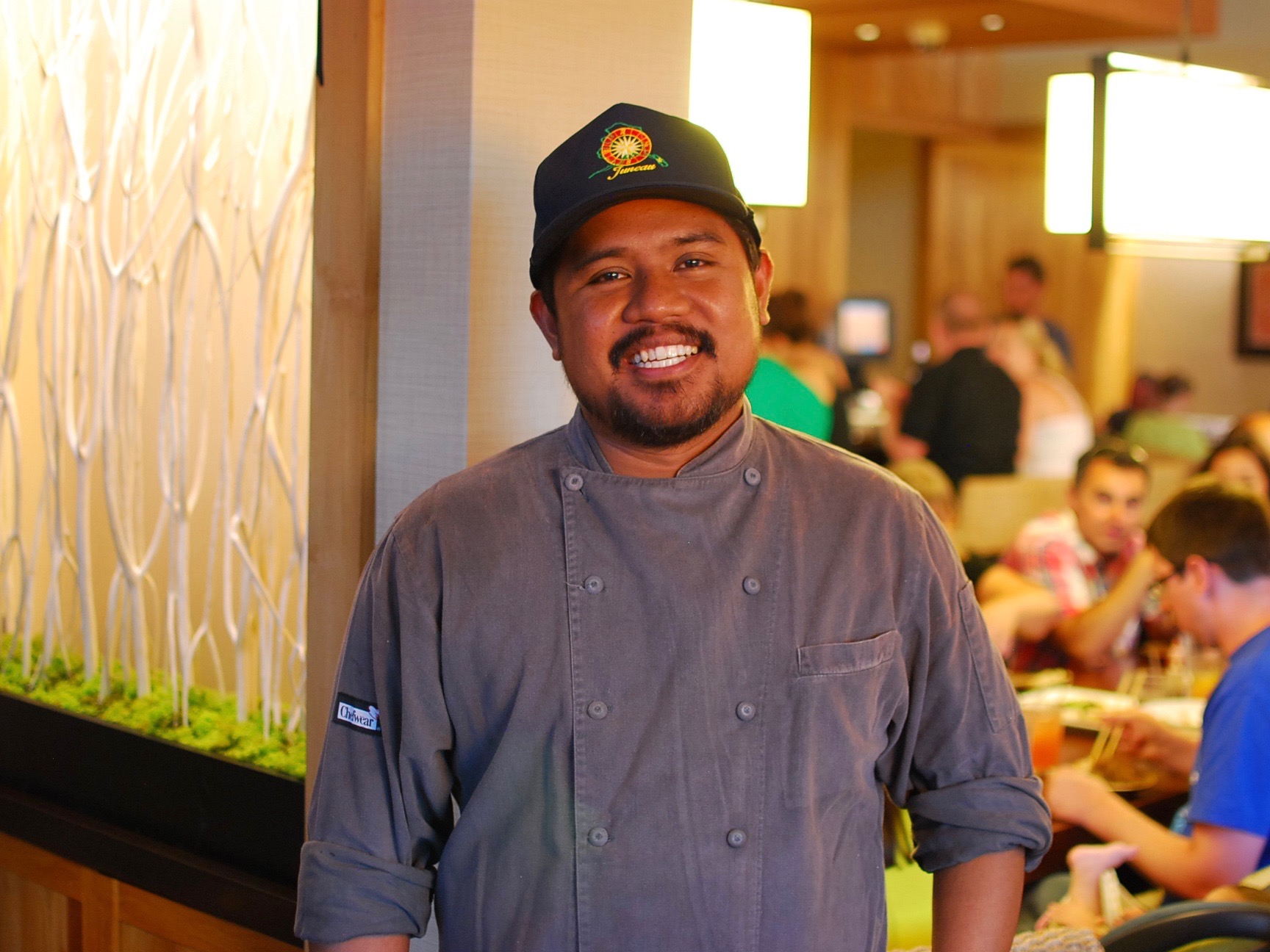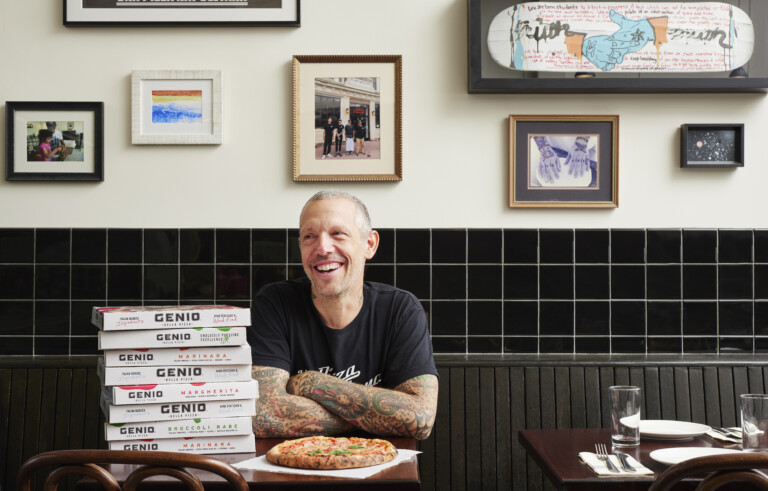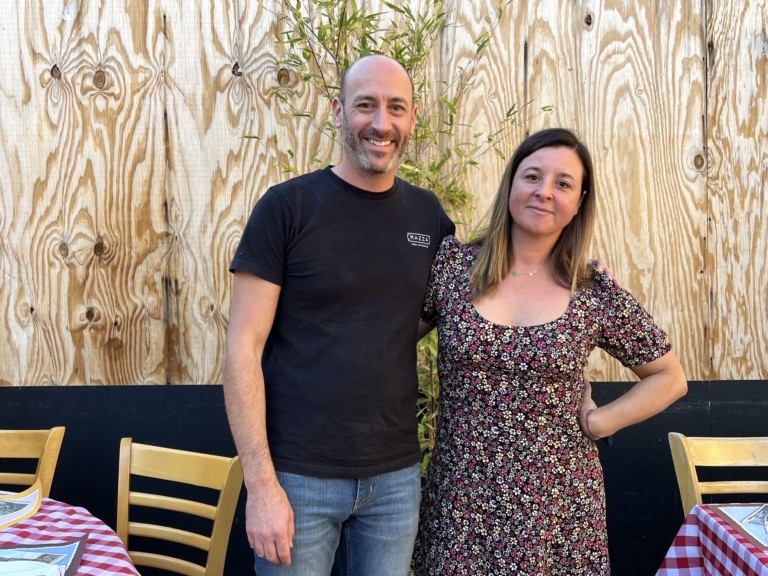Big Island native Sheldon Simeon arrived in Maui by way of Walt Disney World and now oversees the culinary direction for Old Lahaina Luau, a company that dates to 1986 and includes >Aloha Mixed Plate, Star Noodle and Leoda’s Kitchen and Pie Shop. We met at Star Noodle and Simeon, a contestant on Top Chef Season 10, shared culinary insights.
Joshua Lurie: Was it a given that you would become a chef, or did you consider other careers?
Sheldon Simeon: Going through high school, I wanted to be an architect, so then I took mechanical drawing through my freshman, sophomore and junior year. Senior year started and I started hanging out with the boys, started to go surfing, so I was like, “Do I really want to go to a four-year college?” My family were amazing cooks. If there were ever any family gatherings, we’d be the house that did all the cooking. I knew how to cook pretty good. My brother went to culinary school. I’d see how he’d go cruising, and he got to hang out with everyone, so I went to culinary school and found out I liked it and was kind of good at it, so it became a passion.
JL: Where did you go to culinary school?
SS: I started off at Leeward Community College up on Oahu, on Waipahu. I went to one semester there, did the internship at Walt Disney World, met my wife, spent one more semester at Leeward, then moved to Maui and graduated from there.
JL: What was your very first night like in a professional restaurant kitchen, and where was that at?
SS: First professional night was at Walt Disney World, at the Living Seas at Epcot Center.
JL: What was that night like?
SS: The one that stands out to me, I got put on the fry station and the first couple weeks wasn’t that bad. I was cleaning carrots and doing the normal gofer – go stand in the corner and peel all these potatoes – but what I actually remember is being on the line that first night. We would sandbag the chicken tenders. We’d cook a whole batch and put them underneath heat lamps. I was so busy all night so I kept that going and we were five minutes to closing and I dropped two whole baskets of it, not knowing that here comes the chef around the corner: “Who dropped all those chicken tenders?!” We ended up throwing away a whole case of chicken. That one sticks out for me, the 18-year-old trying to do it all and keep the tenders.
JL: How did your current opportunity come about?
SS: For me, I just made 10 years with this company. How I started with this company, I was visiting my wife, and I said, “If I can ever get a job here, I’d move to Maui.” We ate down at Aloha Mixed Plate, and I had a friend from high school who was working there. “Do you have an opening for a job?” “Yeah, we have an opening for a dishwasher and a prep cook.” I got hired right then. I started off as a dishwasher and a prep cook for this company and worked my way up to become the executive chef of the two restaurants.
JL: What does a dish have to be for you to serve it at Star Noodle, and how is that different from Leoda’s? Are there any common threads?
SS: Each restaurant has their brand. We definitely want to support local. We stick very true to the Star Noodle brand with the noodles and local influence, a lot of Asian flavors. For Leoda’s, I just keep on saying glorified Grandma. It’s making everything from scratch. There’s no Asian influence. It’s very homey, very rustic.
JL: What’s the first dish that you ever remember making growing up? You said you would eat ramen instead of cereal.
SS: Local, we call ramen saimin. That’s the first dish, open up a top ramen bag, there’s an MSG packet. To this day, I’m guilty of it. I’m surrounded by fresh noodles every day, I still go home and eat my top ramen. My daughter, she’s five years old, and she can cook herself some saimin. She’ll go, “I’m hungry,” and go make herself some saimin noodles. I think everyone in Hawaii grew up with top ramen in their cabinets.
JL: What’s your favorite part about working in restaurants?
SS: At first, when I was starting my chef career, it was being on the line and getting through the rush, and now it’s turned to being on the mentor side and seeing the next tier of chefs. I give them the same opportunities that I’ve had. I’ve been blessed with so many opportunities from this company. I cannot thank the owners enough for the success. We go on trips. We’ve been to San Francisco and to Napa.
We’ve gone to Ann Arbor, Michigan, to develop our breads with Zingerman’s. We were out there for a week. We were having difficulty making bread because of the humidity here in Hawaii. How do we get bread like San Francisco? We couldn’t figure it out. We do noodles great, but there’s not a big bread culture in Hawaii, at least how San Francisco or whatever is. We’ve always had a great relationship with Zingerman’s. We share the same philosophy as their management system and their leadership system. We went out there and asked if they could help with our breads. To me, they’re amazing. It’s what makes our sandwiches.
JL: What was the trick with dealing with the humidity?
SS: Playing with the different hydrations, and the amount of water that was needed. We needed help on our formulas for each dough, and figuring out, What do we do when it comes out of the oven? How do we serve it? How do we keep this crust? We just broke down each recipe side-by-side because their knowledge is more than we could ever have.
JL: What do you look for when you’re hiring somebody to work in one of your kitchens?
SS: We look for that passion, definitely. That skill set, for me, especially coming up being a local boy, not being able to go to a big culinary school like Culinary Institute or working in high-end restaurants, just their passion, and if they want to work hard, I may not be the most talented chef, but I worked hard for the success of the restaurant. It’s what you want to put into it. I’m constantly learning, still. We all make mistakes, but it’s what you do when you move on from there. We have a lot of great guys. Only one of them went to culinary school.
JL: What’s the biggest challenge about managing multiple operations?
SS: You don’t want to spread yourself too thin. The biggest challenge is that you always want to be there constantly for the crew, but like this trip – removing yourself sometimes – you have to learn to trust your team. It’s about me letting go and let the team shine and trust in them. Food for me is so personal. I don’t want to sound romantic about it, but it is. You can taste it, you can feel it, there’s so much memory, when you eat something, “Oh, this tastes like whatever.”
JL: What’s the most recent dish that you came up with, and what was your inspiration?
SS: Filipino bacon and eggs. That one’s fun. We were starting to think, “How can we evolve our menu to be a little bit more modern?” We see what people are doing along the scales of this, their style of food and what’s going on, on the mainland. Take a step back and not even worry about what the fads are. Let’s make a dish that we want to eat just for the hell of it. That’s how we came up with bacon fat and eggs. We’re not flavoring it with any fancy vinegars or olive oils. It’s straight up fish sauce and regular Heinz apple cider vinegar, which you can find at home. Again, the memory of having it, that’s the type of food when we’re drunk, sitting home at night, “Oh man, what do I want to eat?” That and top ramen.
JL: What’s the dish you sell the most of at each restaurant, and why do you think?
SS: Pohole Salad for [Star Noodle]. For me, that’s the exact same dish, the way my dad makes it. I think that’s the kind of philosophy of our style of food. We want to serve what we grew up with and what we know. There’s influence from New York restaurants and Momofuku, that style too, but the dishes that really ring true of what we are, are dishes like Pohole Salad. To go to a family party and in the cooler, left over is a Ziploc, and you’ll find that same salad. We’ve got technique to it, blanching the pohole salad correctly, using techniques and adjusting the amount of umami that we add into. That’s umami overload.
JL: What about at Leoda’s, what’s your top seller there?
SS: At Leoda’s, it’s our seared ahi sandwich. That’s just seared Grade A tuna with garlic aioli, basil pesto, caramelized Maui onions and Waipolu watercress, all on a toasted rye bun. It’s the layers of flavors, it’s the freshness of the ahi. I love that one.
JL: Is there anything you don’t enjoy eating?
SS: Mint. I enjoy cooking with it, and I understand why everybody enjoys mint, so I put it in a lot of my cooking and know everyone enjoys it, but me, personally, I stay away from mint. I don’t like mint chocolate chip ice cream. That’s my worst enemy, but my wife loves it. Everybody else in the kitchen loves it. Sometimes we throw ice cream parties. “You guys want ice cream, I’ll get you guys ice cream.” “Mint chocolate chip!” “Can someone else get that please?”
JL: How are you able to maintain balance in your life?
SS: It’s difficult. I have the most supportive wife I could ever ask for. She’s amazing. I have three girls, three daughters, one, three years old and five years old. I think the Lord above a lot for having a wife that’s so understanding. Hopefully all of this hard work can pay off and later on I can take a step back. It’s already happening. My sous chefs and my team are blossoming. The time’s coming, for sure.
JL: You were saying the future of Hawaiian cuisine is going back to the roots?
SS: The future of Hawaiian cuisine is definitely going back to the roots and seeing where our food and our ancestors came from. The whole genealogy of Hawaiian cuisine can be told through the taro plant. It’s weird. They call the small plants keiki, which is the children, and then stalk represents the family tree, and then it blossoms. The root is like the grandparent. That food culture is cool too, to see how Hawaiians viewed food, and to see how we’re using it in cuisine we’re doing nowadays.
JL: Are you using more and more of what was always available on Hawaii?
SS: Definitely. We just picked up 70 acres, so we’re going to be starting our own farm. We’re going to be doing all our own vegetables and herbs from our farm. That’s very exciting.
JL: Some vegetables you don’t already have?
SS: We’re going to be doing definitely what we already use, the classics. We already do our own poi, our company. We have a farmer who’s really knowledgeable in ancient Hawaiian farming, so we’ll look back there and see what grows in different regions. There are so many different climates in Hawaii, all the way from Mauka to Makai and from the mountain to the ocean, and whatever’s in between.









Leave a Comment